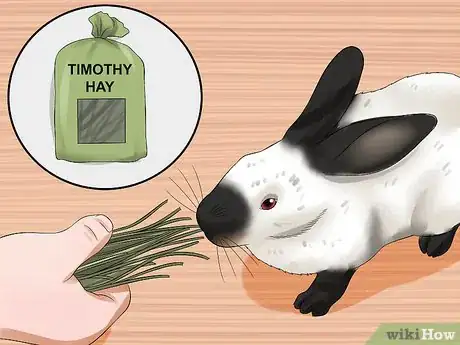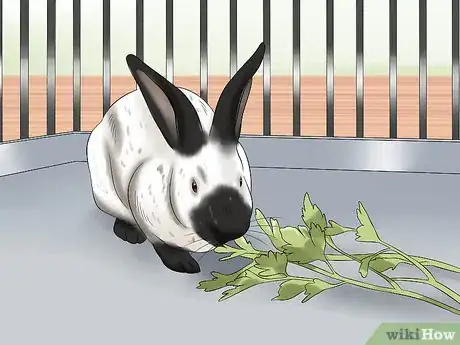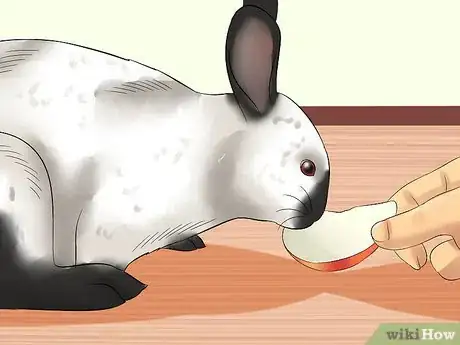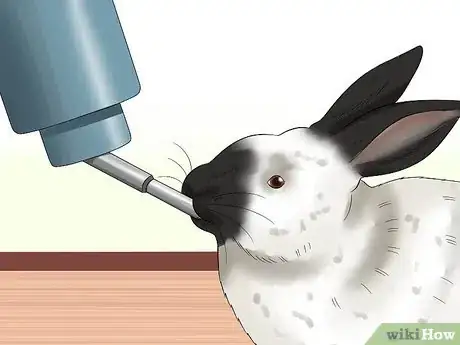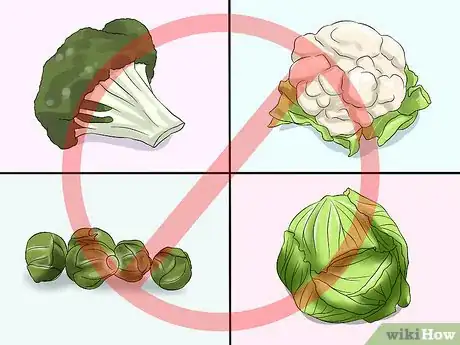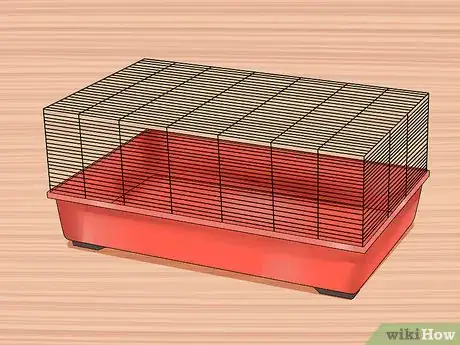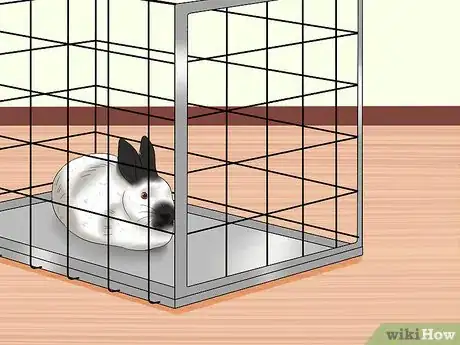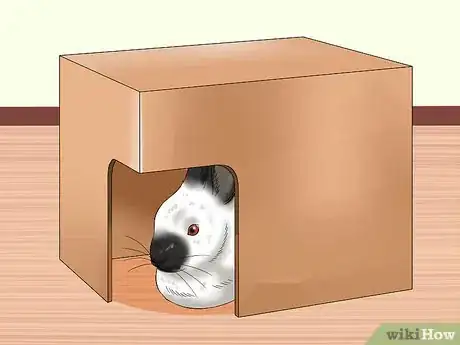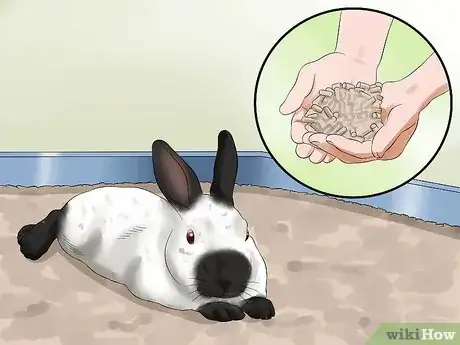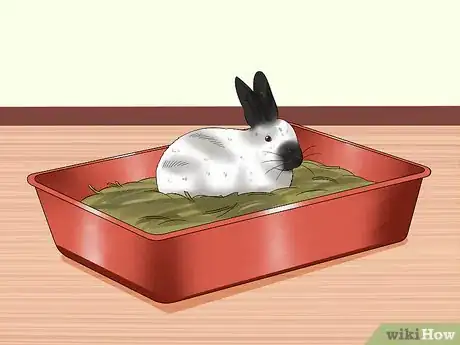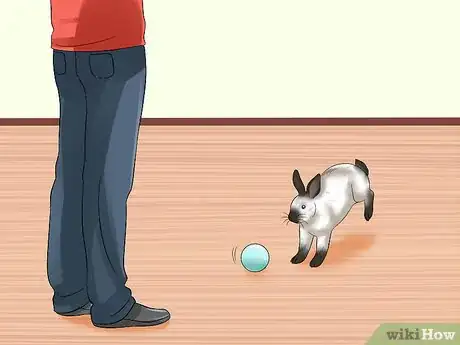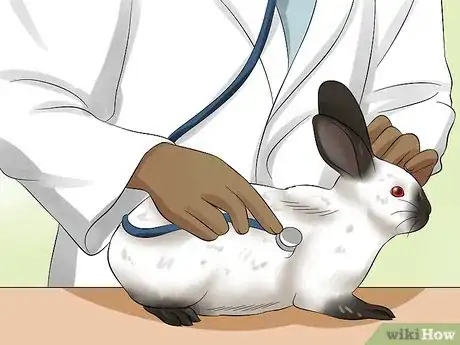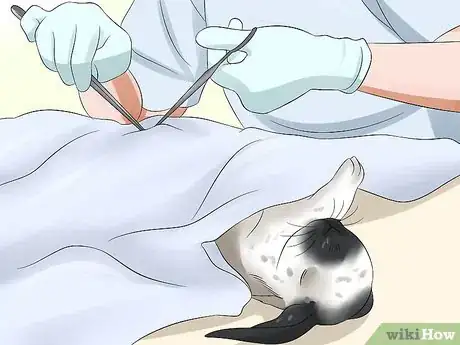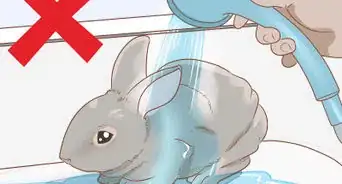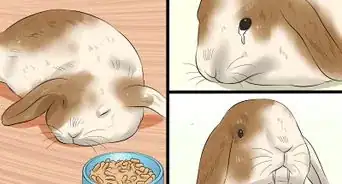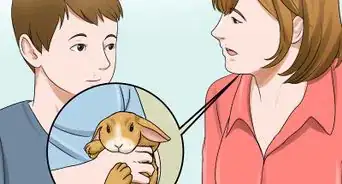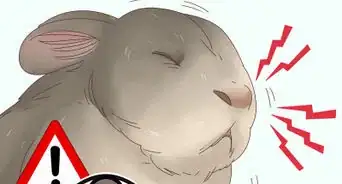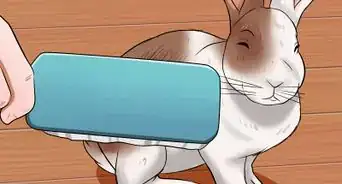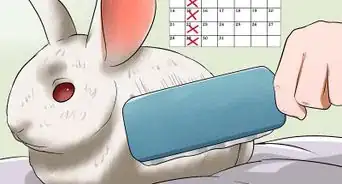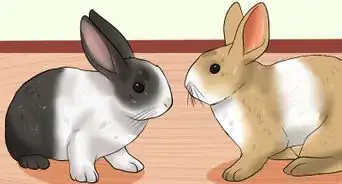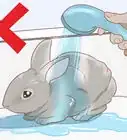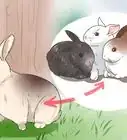This article was co-authored by Pippa Elliott, MRCVS. Dr. Elliott, BVMS, MRCVS is a veterinarian with over 30 years of experience in veterinary surgery and companion animal practice. She graduated from the University of Glasgow in 1987 with a degree in veterinary medicine and surgery. She has worked at the same animal clinic in her hometown for over 20 years.
There are 8 references cited in this article, which can be found at the bottom of the page.
This article has been viewed 21,952 times.
Californian rabbits have red eyes, white fur, on their bodies except for the darker fur on their feet and ears. The dark fur may be chocolate, black, blue, or lilac.[1] Californian rabbits are friendly and easy-going, so they make great pets.[2] If you have a Californian rabbit, then you will need to learn about the feeding, housing, and other care needs of this rabbit.
Steps
Feeding Your Californian Rabbit
-
1Provide lots of high quality hay. Hay is the most important food for your rabbit’s health, so make sure that she always has access to lots of high-quality hay. Hay helps to provide your rabbit with the nourishment she needs and wears down her teeth as well.[3]
- Timothy hay is a great choice for Californian rabbits.
- Make sure that your rabbit has access to unlimited hay every day.
-
2Give your rabbit some plain pellets. Pellets made especially for rabbits will also provide your rabbit with some good nutrition, but she will not need much of this type of food to stay healthy. Limit your rabbit to about ¼ of pellets per day. She may need more or less depending on her weight. Check with your veterinarian to be sure.[4]Advertisement
-
3Keep some dark leafy greens in your rabbit’s cage. Dark leafy greens are also great for your rabbit, so offer your rabbit some of these every day as well. Some good leafy green choices include:[5]
- kale
- mustard greens
- collard greens
- basil
- parsley
-
4Treat your rabbit to some crunchy things. Rabbits are fond of fruits, veggies, and seeds that they can crunch on, so try to include a few treat items in your rabbit’s diet. Some good treat items include:[6]
- carrots
- apples
- peeled banana slices
- hulled sunflower seeds
-
5Place water in a ceramic bowl or sipper bottle. Your rabbit always needs to have access to clean, fresh water. A sipper bottle is ideal because it will not get dirt or debris in it. Check the water level often and change the water in your rabbit’s cage at least once per day.[7]
-
6Learn what foods are bad for your rabbit. Some foods are not ideal for your rabbit, so always check with your rabbit’s veterinarian before offering your rabbit a new type of food. Some foods that you should not give your rabbit include:[8]
- broccoli
- brussel sprouts
- cabbage
- cauliflower
- spinach
Preparing Your Californian Rabbit’s Cage
-
1Choose a cage that is large enough for your rabbit. When choosing a cage for your rabbit, keep in mind that he will need some room to hop around. Try to choose a cage that is at least 30 inches long by 24 inches wide by 18 inches high.[9] Cages range from simple types to rabbit condo types.[10] [11]
-
2Place your rabbit’s cage indoors. Californian rabbits should never be kept outside. You need to keep your rabbit indoors to protect her from predators, bad weather, and loneliness. Even if your rabbit is safe within her cage, the sight of an approaching predator may give your rabbit a heart attack and kill her.
-
3Give your Californian rabbit a hiding place. If the cage you choose for your rabbit does not include a hiding spot, then you will need to place a cardboard box or a wooden nest box for your rabbit to hide inside. Rabbits feel more secure if they have a place to retreat to when someone approaches their cage or just when they are feeling nervous.[12]
- Rabbits seem to like cardboard boxes because they can move them around, chew on them, and hide in them.
-
4Lay down plenty of pelleted paper bedding. Pelleted paper bedding is appropriate for rabbits, but you can also use hay if this material is not available. Make sure that you avoid cedar and pine bedding because these materials can cause respiratory and liver problems.[13]
-
5Provide a litter box. Your Californian rabbit will use a small litter box if you provide one for her. Place the litter box in one corner of her cage. Put down a few sheets of newspaper in the litter box and lay hay over the newspaper. Empty the litter box and refill with clean materials daily.[14]
- If you notice that she is urinating in a different corner of her cage, then just move the litter box to that corner.
Protecting Your Californian Rabbit’s Health
-
1Protect your Californian Rabbit from household hazards. It is a great idea to let your rabbit out of her cage now and then so that she can run and play, but make sure that the environment is safe before you do so. Some things that you will need to do include:[15]
- Hiding or covering electrical cords. Rabbits will chew through electrical cords, so cords need to be hidden with spiral wrap, hard plastic tubing, and or by keeping them out of reach.
- Watching your rabbit around wood. Rabbits will chew on wooden objects including wall trim, door edges and wooden furniture legs. Rabbits may also chew on wallpaper, sheetrock, and carpeting. Watch your rabbit around these items or keep your rabbit away from them.
- Providing chewing alternatives. Always make sure that your rabbit has some acceptable chewing alternatives. If you catch your rabbit starting to chew on something he shouldn’t, then give him the alternative. You can give your rabbit items like alfalfa cubes, untreated pine boards, cotton towels, or apple branches.[16]
-
2Ensure that your Californian rabbit gets plenty of exercise every day. Rabbits need about two to three hours of exercise per day to stay healthy, so ensure that your rabbit has plenty of opportunities to run and play. You will need to let your rabbit outside of your cage to let him run and play.[17] Make sure to supervise him during this time.
-
3Take your rabbit for an annual veterinary checkup. Do not wait until your rabbit is sick to take her to the veterinarian. Take your rabbit for a checkup once per year to make sure that she is healthy. Of course, if you do notice signs of a problem, then take your rabbit to a veterinarian right away. Signs of a problem include:
- watery diarrhea
- not defecating
- runny eyes
- runny nose
- dark red urine
- fur loss
- lethargy
- drooling
- not hopping
- fever of 105 degrees Fahrenheit or more[18]
-
4Get your rabbit spayed or neutered. Rabbits can reproduce often and fast, so spaying and neutering are essential to preventing unwanted litters. Female rabbits are also at a much higher risk of uterine cancer if left unsprayed. Spaying and neutering can also prevent your rabbits from engaging in spraying and other negative behaviors due to sex hormones.[19]
- If your rabbits are not spayed or neutered, then you will need to keep the males and females separated to prevent unwanted litters.
Expert Q&A
-
QuestionHow long does a Californian rabbit live?
 Pippa Elliott, MRCVSDr. Elliott, BVMS, MRCVS is a veterinarian with over 30 years of experience in veterinary surgery and companion animal practice. She graduated from the University of Glasgow in 1987 with a degree in veterinary medicine and surgery. She has worked at the same animal clinic in her hometown for over 20 years.
Pippa Elliott, MRCVSDr. Elliott, BVMS, MRCVS is a veterinarian with over 30 years of experience in veterinary surgery and companion animal practice. She graduated from the University of Glasgow in 1987 with a degree in veterinary medicine and surgery. She has worked at the same animal clinic in her hometown for over 20 years.
Veterinarian The average lifespan of a Californian rabbit is 5-10 years. With an appropriate fibre-rich diet and good preventative health care (such as spaying), there is no reason not to expect the rabbit to reach double figures in age.
The average lifespan of a Californian rabbit is 5-10 years. With an appropriate fibre-rich diet and good preventative health care (such as spaying), there is no reason not to expect the rabbit to reach double figures in age. -
QuestionHow big does a Californian rabbit get?
 Pippa Elliott, MRCVSDr. Elliott, BVMS, MRCVS is a veterinarian with over 30 years of experience in veterinary surgery and companion animal practice. She graduated from the University of Glasgow in 1987 with a degree in veterinary medicine and surgery. She has worked at the same animal clinic in her hometown for over 20 years.
Pippa Elliott, MRCVSDr. Elliott, BVMS, MRCVS is a veterinarian with over 30 years of experience in veterinary surgery and companion animal practice. She graduated from the University of Glasgow in 1987 with a degree in veterinary medicine and surgery. She has worked at the same animal clinic in her hometown for over 20 years.
Veterinarian The average weight of a Californian rabbit is 3.5 to 5.0 kg. The females tend to be smaller than the males.
The average weight of a Californian rabbit is 3.5 to 5.0 kg. The females tend to be smaller than the males. -
QuestionWhat are Californian rabbits used for?
 Pippa Elliott, MRCVSDr. Elliott, BVMS, MRCVS is a veterinarian with over 30 years of experience in veterinary surgery and companion animal practice. She graduated from the University of Glasgow in 1987 with a degree in veterinary medicine and surgery. She has worked at the same animal clinic in her hometown for over 20 years.
Pippa Elliott, MRCVSDr. Elliott, BVMS, MRCVS is a veterinarian with over 30 years of experience in veterinary surgery and companion animal practice. She graduated from the University of Glasgow in 1987 with a degree in veterinary medicine and surgery. She has worked at the same animal clinic in her hometown for over 20 years.
Veterinarian The breed was originally developed for commercial purposes, to produce meat and fur. However, this practice has fallen out of favor and now they are mainly kept as pets.
The breed was originally developed for commercial purposes, to produce meat and fur. However, this practice has fallen out of favor and now they are mainly kept as pets.
Warnings
- Never pick up your rabbit by the ears or only around the chest. Instead scoop your rabbit up from the rear with one hand and keep the other hand under your rabbit’s chest. Holding a rabbit the wrong way can cause him to kick and may even break your rabbit’s back.⧼thumbs_response⧽
- Rabbits produce soft stools at night, but this is normal. It is not diarrhea.⧼thumbs_response⧽
References
- ↑ http://www.raising-rabbits.com/californian-rabbits.html
- ↑ http://www.thenaturetrail.com/rabbit-breeds/californian-rabbit-breed-information/
- ↑ http://www.spca.org/page.aspx?pid=430
- ↑ http://www.spca.org/page.aspx?pid=430
- ↑ http://www.spca.org/page.aspx?pid=430
- ↑ http://www.spca.org/page.aspx?pid=430
- ↑ http://www.spca.org/page.aspx?pid=430
- ↑ http://www.spca.org/page.aspx?pid=430
- ↑ https://www.animalhumanesociety.org/adoption/rabbit-care
- ↑ http://www.spca.org/page.aspx?pid=430
- ↑ http://myhouserabbit.com/rabbit-care/housing-your-pet-rabbit-indoors/
- ↑ http://www.spca.org/page.aspx?pid=430
- ↑ http://www.spca.org/page.aspx?pid=430
- ↑ http://www.spca.org/page.aspx?pid=430
- ↑ http://rabbit.org/faq-rabbit-proofing/
- ↑ http://rabbit.org/faq-chewing/
- ↑ https://www.animalhumanesociety.org/adoption/rabbit-care
- ↑ www.merckvetmanual.com/pethealth/exotic_pets/rabbits/routine_health_care_of_rabbits.html
- ↑ http://www.spca.org/page.aspx?pid=430
About This Article
If you want to properly care for your Californian rabbit, make sure it always has access to lots of timothy hay, which will not only give it nutrients it needs, but it will also wear down its teeth. You can also give your rabbit about 1/4 cup of plain pellets per day, just don’t give it more than it needs since pellets don’t have all the nutrients your rabbit needs. On the other hand, dark leafy greens like kale, basil, and parsley are great for your rabbit and should be given to it every day. Crunchy foods make for another good snack, so feel free to give it plenty of apples, carrots, and hulled sunflower seeds. While your rabbit will enjoy lots of fresh veggies, they can't eat all of them, and you’ll need to avoid giving it broccoli, Brussels sprouts, cabbage, cauliflower, and spinach. For more tips from our Veterinary co-author, like how to prepare your rabbit’s cage, read on!
